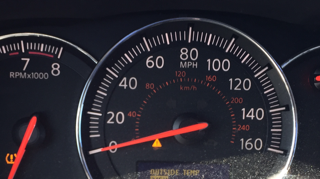I love the dashboard in the car. Not only do I like how it looks, I like how it provides me with a lot of valuable information. There is a computer screen that displays GPS information, as well as some statistical information regarding the gas mileage and several other things I do not pretend to understand.
To me, the dashboard of a car provides two types of information; current status and summary.
Current status information provided could include speed, gas levels, RPM, tire pressure, and possible engine problems. This is all critical information while I am operating the car. Based on the information in front of me, I can make adjustments as needed to my speed, or decisions regarding when I need to stop for gas or service. Without this type of information in front of me, I would probably owe a lot of money for speeding tickets, and I would often find myself on the side of the road because I ran out of gas, had a flat tire, or broke down.
Summary information could include statistical information such as average mile per gallon. This type of information is gathered by looking at data over a period of time. Summary information, such as gas mileage, helps me understand the cost of operating my car.
Imagine if I could enter the cost of gas over the past several months into the computer in my car, then the dashboard could show me information like how much it costs me to go to the store, or to drive into the city. Displaying how much it costs to drive to the store instead of the average gas mileage would instantly show me something I understand; money. However, I have to translate the mileage on the car into a dollar value if I want to know that information, so needless to say, I don’t know how much it costs me to drive to the store or into the city.
If you are an IT Asset Manager, you might have a lot of valuable information at your fingertips such as information that can help your organization make better decisions about IT spending and information regarding how IT assets are performing. The problem many IT managers face every day is communicating the valuable information they have in such a way that non-IT business managers can understand. Nobody wants to convert gas mileage into a dollar amount every day, just like non-IT business managers don’t want to translate uptime, downtime, or any IT lingo into costs.
ITAM dashboards, mixed with the right ingredients, can help you instantly communicate the value of the information you have in such a way that business managers and executives will understand. With this information, they will become informed and as a result, make better IT decisions.
IT dashboards can provide pinpoint data relevant to business objectives. The benefit that comes from dashboards is increased knowledge about the current state of the business. Dashboards can help business managers quickly determine:
- Where are we now?
- Where do we want to be?
- Are we performing on schedule to meet objectives?
- What adjustments do we need to make?
Gartner defines dashboards as follows:
The problem an IT department will have when creating dashboards is that mid-level business managers from different departments might have different business objectives. Furthermore, upper-level management will require summarized data from all of the organization’s departments. As a result, dashboards need to be aligned with the different business objectives of each department so they can add value.
IT asset management touches all departments within an organization. Whether it be HR, finance, sales, or marketing, they all need tools provided by the IT department to meet their objectives. They also need metrics, based on the tools provided by IT, so they can make informed decisions as they work towards those objectives.
ITAM dashboards provide instant visibility into all systems. Some examples of what can be displayed with an ITAM dashboard are as follows:
- Where assets are located
- IT asset cost codes/centers
- Warranty information
- Lifecycle status
- Software license vs. installed software
- Software license information for off-premise cloud solutions
- Software usage
- Software reclamation savings opportunities
- Vendor and Partner information related to IT assets
- Asset performance measures (when integrated with ITSM information)
- BYOD information
- Asset lifecycle cost
ITAM dashboards or other dashboard software provided by similar companies to Bamboo Solutions and others, can provide insight for business managers throughout the organization, both inside and outside of the IT department. With properly designed dashboards, business managers will see IT asset information relevant to their objectives from an asset perspective. For example, a business manager would be able to monitor whether or not provided software tools are being used.
To build meaningful ITAM dashboards, I suggest the following ingredients:
- Build dashboards integrated with ITSM data
- Display trends
- Create queries aligned with each department’s strategy and objectives
- Create business value dashboards (BVDs)
Build dashboards integrated with ITSM data
An ITAM database will contain information about an asset such as the cost, contracts, asset names, location, ownership/cost center and the lifecycle of the asset. With software assets, the license information and usage information would be included as well. When you integrate ITSM data into your ITAM dashboards, you will be able to identify performance metrics based on how often assets are repaired or replaced.
Adding ITSM data helps you identify the total cost of the asset by showing you how much it costs to support the asset during its lifecycle.
In Part 2, I will discuss the following dashboard ingredients:
- Display trends
- Create queries aligned with each department’s strategy and objectives
- Create business value dashboards (BVDs)
-follow me on Twitter @marcelshaw

